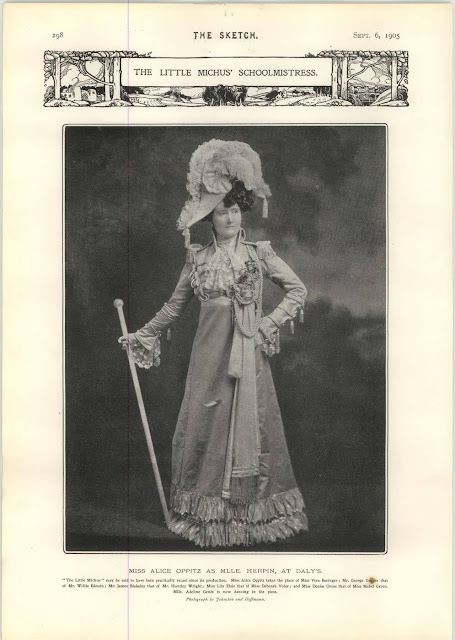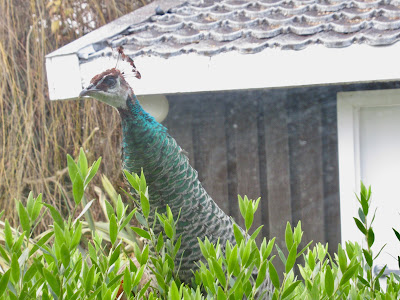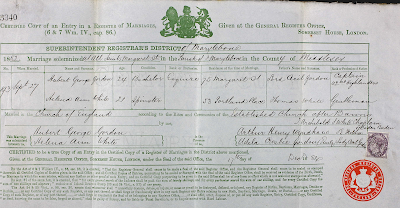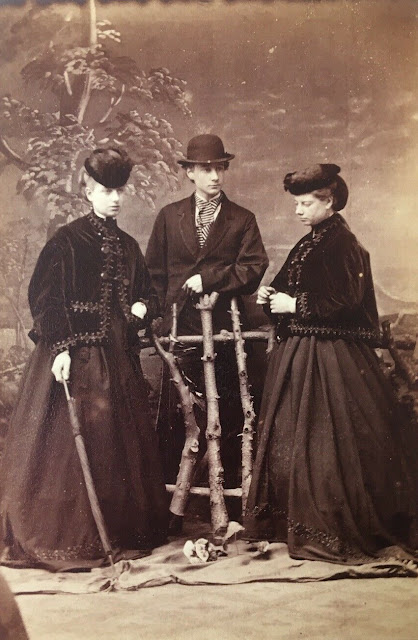.
A fun, but, occasionally, frustrating, day. Pinned down eight folk, but a few others refuse to give up their identity, so although I have their careers -- large or small -- sorted, they have to wait. Josephine Findlay, Charles Rowan, Violet Russell, James Appleton ... into the Vere-St Maur box, until I take you out for another go.
But, on the credit side, green light for Amy Farrell, J W Foster, Alec Romer, Rose Rosslyn, Charles Goold, Constance Ethel Hyem, Alice Aubrey, G W Marnock ... and the chickens
Amy [Kathleen] FARRELL (b Blackrock, Dublin 10 March 1872; d Prior Place, Heatherside, Camberley 11 May 1934)
Amy Farrell and her sisters Clara ('Cissie') and Laura were born into the theatre. The Surrey Theatre, to be precise. For their mother was 'Ada Conquest' (Amelie OLIVER), daughter of Benjamin Conquest (né Oliver) and sister of 'George Conquest' manager of the Surrey. Their father was Henry Farrell.
Amy made what seems to have been her first named appearances at the Surrey. She ('a comely damsel of sixteen') and Cissie played in the 1889, 1890 and 1891 pantomimes, and in pieces such as A Ring of Iron, Alone in London and doubtless others, of all types, in between. The Surrey was a grand place for learning one's trade. They also appeared in the odd outside matinee (Good Queen Bess at the Vaudeville, Rita in The Scribe opposite Lyn Cadwaladr).
Amy joined the D'Oyly Carte in 1892, and served there in The Nautch Girl and The Vicar of Bray before moving on to play in Landon Ronald's forepiece Did You Ring? at the Prince of Wales, and as the Spirit of Bow Bells in the Olympic Theatre's Dick Whittington ('pretty presence and excellent singing'). Pantomime was to be an annual event .. Jack and the Beanstalk at the Crystal Palace (1893), Santa Claus at the Lyceum (1894, Queen Mab), Birmingham (1895) and Glasgow (1896, Maid Marian). In between she appeared in any sort of performance available
I wonder who Mr Willey was! Miss Serpell from Truro was Mrs Dale.
In 1897 Amy was cast as ingenue Millicent Warfield in the Waltons musical Skipped by the Light of the Moon ('pleasing voice and much charm') along with little sister Laura, Rudolph Lewis, and Isa Bowman, for whom Amy deputised on occasion. However, come Christmas, it was off to Dublin for Aladdin. In 1898 she played in The JP at the Strand and on tour, in Arthur Roberts' musical tryout Campano, and in Aladdin at Brixton, in 1899 she was Therese in the provincial musical Black and White, took up her old part in the attempt to turn the hugelysuccessful Skipped into a West End musical, and, in 1900, went on tour for George Edwardes as Dorothy in A Runaway Girl. When it wasn't panto time (Aladdin Hull 1899, London Hippodrome as Cinderella 1900).
And then it all came to an end. Amy married Manchester actuary Arnold Louis Schuster (1873-1954) had two daughters, left the stage, and, subsequently, it seems, also Mr Schuster. In 1911 she is with Mama in a Hove boarding house. In 1929, in London's Cromwell Rd ...
J W or John Warren FOSTER [FOSTER, John William] (b Harrogate, 26 March 1868; d King John's House, Thundersley, Essex 20 February 1941)
John Foster was born in Harrogate, and would later call both himself and his father 'Esq'. Actually, his father, Charles Foster, was a plumber and gas-fitter, and his Pocklington-born mother took in lodgers. Young John started his working life as a grocer's assistant. He also may have been the J W Foster who won a prize for his pigeons in the 1887 show, but maybe not: Mr J W Foster 'of Wintringham' and 'of Wistow' would go on winning prizes for pansies, cut flowers, eggs, beans et al when our John has exchanged his apron for the Royal Academy of Music.
My first sighting of J W on a concert platform is in Bristol (Evenings for the People) in 1891, the second is at the RAM where he sang Papageno, Escamillo and Daland in the opera class concerts (1894-5). In 1896, he was cast as Lord Kempton in the musical comedy Newmarket, took a spell at the Savoy, then returned to Newmarket. He was back at the Savoy for The Beauty Stone, and in 1900 played at the Lyceum in Anthony and Cleopatra with F R Benson.
In 1901, Foster found his niche. He was cast in the fine role of Sir John Binfield in the tour of Kitty Grey (1901-2) and thereafter was seen in the British provinces as Florestan in Véronique, Danilo in The Merry Widow, Alexis in King of Cadonia et al. He also appeared in London in a small part in the disappointing A Persian Princess (1909).
The Merry Widow is my last sighting of him as a player. He retired to Rayleigh, Essex, with his wife Florence Talfourd (née Major 1858-1924), sister of the vicar of Thundersley, to farm chickens and breed .. you guessed it .. breed homing and racing pigeons.
I see him donating messenger birds to the war effort, chairing local poultry meetings, singing at a pigeon fanciers do, opening the local bazaar, and caring for the composer Herbert Bunning in his dying days
After his wife's death, he married (15 May 1926) the much younger Winifred Alice née Ingle (b 9 March 1897; d Harlow 10 January 1968), who can be seen running a local Land Army hostel in the second war. At his death, he left her 910L. And, hopefully, King John's House, Thundersley, which had been their home for many years.
Alec ROMER [WOOODMAN, Alexander] (b Brixton 1871; d Horton Asylum, Epsom 23 March 1909)
Alexander (no Haines) Woodman was born in Brixton, the fourth child of 'general agent' Thomas Haines Woodman (d 1896) and his first wife, Mary née Christie. Quite what inspired him to have the dubious taste to take the surname 'Romer' (decades earlier, famous in the operatic world), but it was as Romer that he appeared aged 21, on tour with Horace Lingard's company (The Old Guard, Pepita etc), and then with the Carte companies (1892 ssq). He is said, in 1896, to have married Carte chorine, Margaret Radcliffe (b Shrewsbury 1875), but unless her real name were Annie Elizabeth Jones, I can't find the record. In the 1901 census she says her name is 'Margaret Romer'. Bah!

I see them, in 1896, singing together at the Blackpool Winter Gardens, at Reading Queen's Hall and at the Bath Theatre of Varieties ('Marguerite Radcliffe'), and I see Alec taking over a role in the touring musical Runaways in 1902, while Marguerite is singing on the pier at Hastings. It may be he, in 1905, 'Mr Romer' in the chorus of Mr Popple of Ippleton at the Apollo Theatre. No sign of la belle Marguerite. She may have left, for soon after Alec was admitted to the Horton Insane Asylum, a new institution in Epsom, established largely to deal largely with sufferers from advanced syphilis and paresis. He died there at the age of 38.
As for Marguerite .. well, unless she turned into Miss Marguerite Radcliffe Hall ...
Rose ROSSLYN [TROOSTWYK, Leah Rosetta] (b Hull 1870; d Middlesex Hospital 29 May 1933)

Rose Troostwyk was born in Hull, one of the children of Dutch yeast merchant, Benedictus Troostwyk and his wife, Mary Ann née King. The family took part in local dramatics from childhood, and I first see Rose, aged 27, singing with Arthur Helmore at a hospital concert in Clacton (1897) and at the Withernsea Cricket Club (1898) before, in 1899, she joined the D'Oyly Carte organisation (Rose of Persia, Pirates of Penzance, Trial by Jury at Drury Lane, Merrie England &c). I see her next in a small part in The Duchess of Dantzig ... and then she committed the folly of marriage (15 February 1904). It was folly, because her husband was Harold Robertson Grimston, son of the 'Kendal's. I see a Miss Robertson Grimston with 'a powerful soprano voice' singing at Rutland Barrington's concert in 1906 and playing Mrs van Bridge in his operetta The Turncoats. Harold failed to show. In 1911 he 'merchant' 34, and she, Rose Robertson Grimston aged 60 (!), are in an hotel in Portman Street.
Rose got rid of him in 1916. Co-respondent: Alexander E M D Jordan (who, I presume, was a woman) whom he married 1917. (PS She was a woman: Alexandra Esther Mary Dorothea, multiple names as often proven do not a lady make).
Charles [William Drew] GOOLD (b St Lukes, Middlesex 15 July 1853; d West Ham 8 June 1907)
Charles Goold was another who boasted buttonless flies. But, also, a fair theatre career.
He was the son of schoolmaster, Charles Goold, and Jane Frances (née Monday) who ran a sewing machine team.
He seems to have begun his career with the Carte organisation, as he is censussed in 1881, rooming with Laurence Roche and Thomas Moss in Tomorhan, Devon, where the company was playing. In 1884, he played King Hildebrand (Princess Ida) on tour. Thereafter, he worked largely as a comic actor in the non-musical theatre, in the provinces and suburbs (The Lodgers, The Still Alarm, Cattermole in The Private Secretary, Perkyn Warbeck in Our Boys, Maguire in The Silver Falls, Bubbles in The Bookmaker, The Late Lamented/A Mutual Mistake by W H Denny with time out for panto) before, in 1892, he turned actor--manager. Surprisingly enough, instead of choosing a classic comedy, he elected to produce de Koven's Robin Hood, under its English title of Maid Marian, with himself in H C Barnabee's role of the Sheriff of Nottingham, and Miss Emelie Holt as Marian. Miss Holt had been, for the past few years, the de facto Mrs Goold: de facto0 because there was a real Mrs Goold, née Cecilia Jane Canter, somewhere in the background. Maid Marian was a fine success, and the couple toured from 1892-4. And Cecilia Jane divorced her husband. Revengefully, she cited not only Emilie Holt, but two other females in her petition.

Back in the comic theatre, Goold appeared as Mark Murgatroyd in A Bunch of Violets, Uncle Gregory in A Pair of Spectacles, Simeon Jell in The Co-respondent (with none other than Lydia Thompson) as Mr Pews in Pinero's The Hobby Horse, took a turn back to comic opera to double the roles of Balthazar and Lorémois in C P Levilly's tour of La Poupée, then back for more A Pair of Spectacles, a stock season at Belfast (1896). Madeleine Lucette Ryley's An American Citizen, Nicholas Blount in a serious Kenilworth ... When a little attempt to revive the German Reed repertoire was put on at the Crystal Palace and several home counties venues, Goold joined Leonora Braham, Avalon Collard, Millicent Pyne and Charles Coborn to play Charity Begins at Home et al (1900).
Between 1901-3 he toured as Bob Chaffers in Arthur Robert's company, giving HMS Irresponsible, in 1905 he was Tom Codd in Beauty and the Barge, in 1906 he played The Little Stranger, and in 1907 he died.
The only obituary-ette I have found labels him 'the husband of Emilie Holt'. Which (a) was rather unfair, considering his career and hers and (b) seems to have mixed up fact and de facto. Mind you, not knowing Ms Holt's real name, one can't be utterly sure... Oh! Emilie Holt Goold married late 1907 ... to Mr Caffrey or Mr Piper or .. good heavens! Hamlet Arthur Stammers. Well, it's not Stammers .. oh! bah. I have a feeling that wedcert might hold the odd fib...
Constance Ethel HYEM (b 47 Upper George Street, Marylebone 8 February 1874; d Langley, Bucks 13 April 1928) was a case of double identity.
The lady was christened Constance Ethel, led her early life and career as Ethel, and then changed to being Constance. But, chuckle, she didn't trick me for long. She was born in London, the daughter of Pearl ar Perl Hyem, a solicitor's clerk, and his wife Elizabeth Caroline née Browne, and took part in the productions of the Uxbridge Dramatic Society from teenage days. She studied at the Guildhall, under L F Chapuy, took out several prizes for elocution and reciting, and ... well, I don't believe it, but she has an entry in Who's Who in the Theatre! And it seems to me to be pretty correct.
Debut in Belfast as Nelly Bly with the Carte tour of The Vicar of Bray, four years at the Haymarket, doing bits and covers, Vaudeville Theatre as Pansy in The Cherry Girl, Quality Street et al. Toured in Marie Studholme's role of Cicely Marchmont in The School Girl. Waldorf Theatre in Mrs Temple's Telegram, The Old Firm, a horsey sketch with Arthur Palyfair on the halls, the model, Mimi Vernpn in London's edition of Molnár's The Devil (1909).
Back to the country as Toinette in The Belle of Brittany, principal boy in Jack and Jill at Nottingham, more variety, this time teamed with George Graves, more panto (Aladdin) at Kennington and at the Coronet, a good does of Aggie in Baby Mine, The Glad Eye ..
A nice career, but ... Who's Who?
Ethel had married, in Haymarket days, Albert James Austin, secretary of the City of London School. We see them in the 1911 census, where under nationality he has rightly put 'Irish', and Ethel has put 'cockney'. The couple had a son, Patrick Anslow Austin, at 20 Gower Street 6 September 1906.
Alice AUBREY [SMITH, Alice Kate] (b Dalston 12 June 1857; d 13 Canterbury Rd, Croydon 23 March 1932)
I have met, of course, hundreds of performers who have changed their names, for one reason or another. But I think this is the first time I've met one who had her name changed for her. Alice Smith was born in London, the only child of Mr William Hickman Smith, congregationalist minister and his wife Catherine née Clarke. But the congregations clearly didn't come, for Mr Smith gave up ministering, changed his name to 'Aubrey' and decided to be a journalist. He was still professing 'journalist' in 1911, when the family of three were living in Croydon.
I don't know how often Alice worked. We know she did two overseas tours (Continent and America) with Carte in 1886-8 ... I'm sure I should find her amongst the peasants and villagers of other London musicals. There was an Alice Aubrey at the Empire in 1895, but I don't think it was she. This one was allegedly French and did an act with a performing elephant, ponies, monkeysand dogs. Imagine the feed bill!
Father died 10 February 1916, mother in 1918, and Alice lived alone, in their longtime home till her death in 1932.
G W MARNOCK [WALKER, George] aka Giorgio VALCHERI (b Port Elphinstone, Scotland 1842; d Kelvinside, Glasgow 23 May 1920)
George Walker was born in Aberdeenshire, the son of George Walker 'carpenter employing five men' and his wife Jannet (née Marnock). He spent his early life following his father's trade, and seems to have taken his time to decide on a career in music and the theatre. In fact, I don't see Mr Marnock on a bill until 1880, when he is nearly 40 years of age. But there is a reason. Mr Walker has been out of the country. Dateline 1873:
And then:
'... has made a success in Palermo.. now engaged for La Scala ...'
1875 December 'an important engagement at the Teatro Fraschini, Pavia .. a decided hit as Don Carlo in La Forza del destino ...' with Jose Carrion jr
Camoens in Don Sebastiano 'La barcarola del baritono della quale si chieda ogni sera il bis'...
1876 April Teatro Balbo Turin Saffo, June Catterina di Belp
1876 Bergamo and Alessandria La Forza del destino
'20 April 1878 .. Giuliano in Manlio Bavagnoli's Roderigo di Spagna ...
He is said to have sung Germont to the Traviata of Patti at Genoa.
After seven years, Giorgio came back to Britain, and I see him 27 November 1878 at Dundee's Kinnaird Hall singing Namaan with Aline Osgood, Jenny Pratt and William Shakespeare. And on 2 December he opened at London's Italian Opera as Luna, alongside the Trovatore of Gillandi, the Leonora of Eugenie Pappenheim and the Azucena of Zélie Trebelli. Then as de Nevers in Les Huguenots.
In between times, still billed as Signor Giorgio Valcheri, he appeared in concert in Glasgow, tripped to Scandinavia with Trebelli for a concert series (Tivoli, Copenhagen September), appeared at the Covent Garden proms on one of their better programmes (Sterling, Carrion jr, Mary Cummings, d'Anka, Celli &c) and popped up to Shoeburyness to sing (as 'George Walker') the title-role in Rigoletto in the place of an ailing amateur. And in July 1880, the Signor crept quietly away ... and come October, a re-Scottisised, G W Marnock is playing the Pirate King in The Pirates of Penzance.
And he has just got married. In the 1881 census, Mrs [Julia] Blanche [Impey] Marnock née Lovibond professes that she, too, is an 'artist'. I thought that must be a Victorian scribal error (VSE), but time was to prove me wrong.
Poor Blanche had gone through up and down times. More down that up. She was a young re-un-married woman. Daughter of an Indian army Colonel, she had been sent to school in Britain, and at 22, she married a gentleman named Benjamin Edward Somers. Her experience of married life proved a flop. Mr Somers was 'inept for coition'. Blanche sued for an annulment in no uncertain terms ...
Poor blighter. I hope the judge didn't 'inspect' him publicly. Anyway, Blanche got her annulment, Edward went away and lived, with a poppy or a lily, or something, in his hand, outlived them all, and died a virgin/bachelor in 1932. And George, who presumably wasn't 'inept', married Blanche.
And so 'Mr Marnock' began his career in comic opera. After the Pirate King, he appeared as a 'robust, baritone' Bluebeard in pantomime, sang at various concerts, spent four years touring as Boleslas in Falka, was involved in the non-success of The Punchbowl (1888), and played General Bombardos in Pepita (1888) at Toole's Theatre.
In 1889, he and Blanche visited Australia, which was (as so often) the occasional for long and deptailed articles and biographies, in this case not only of our baritone but of Blanche who, it eventuated, was 'well-known in London as a skilful designer of Christmas cards'. (Table Talk 15 February 1889). During his twelvemonth contract, George appeared in Pepita, Grosvenor in Patience, the Pirate King, Sergeant Meryll, the Mikado (H M Imano was Pooh Bah) and as the Demon to the Cinderella of Clara Merivale. The papers claimed that, on his salary of L27.10s per week, the 'canny Scot' was sailing home with L700 in his pocket. The experience must have pleased him, for the next year he joined Edwin Cleary's company for a trip to South America.
Back in Britain, he picked up his old roles with Horace Lingard's Pepita and Falka companies, and added the curious Brother Pelican while it lasted, he gave his Bluebeard at the Crystal Palace and then went out on tour as 'Brown of Colorado' in The Shop Girl (1895) before visiting Brighton to play the dastardly Captain Barnacle in Dick Whittington. In 1896, he suported Arthur Roberts in Biarritz and played the Emperor in the Drury Lane Aladdin, before putting to bed a splendid theatrical career of twenty baritonic years.
I see the couple in the 1911 census. Blanche is still painting greetings cards of fairies and pansies, and George is now ... a poultry farmer! What is it with Cartesians and chickens ... She died at Knockholt, Kent 7 June 1912, and George returned to Scotland, where he died in 1920. In the 1911 census, the couple admit to 'one child, living'. So maybe there was ...
Well, that's today's lot ... the pile doesn't seem to be decreasing notably. It will soon be time to attack the Millie Vere-Geraldine St Maur box ... oh, boy ....





















































